Nursing Informatics: EHR System Analysis and Testing Report
VerifiedAdded on 2022/08/12
|5
|1091
|62
Report
AI Summary
This report focuses on a nursing informatics project concerning the Electronic Health Record (EHR) system of Universal Health, a non-profit healthcare system. The report addresses the challenges of implementing a new EHR system, specifically the transition from the existing Chrystal system in Oncology North to align with Oncology South. It details the various stages of testing, including integration testing, system enhancement testing, and acceptance testing, and the importance of adhering to regulatory rules. The report emphasizes the need for a standardized oncology solution and highlights the expected outcomes, such as improved efficiency in patient data management, appointment scheduling, and patient referrals. The action plan includes addressing functional gaps identified during testing to enhance patient satisfaction and improve the overall effectiveness of the EHR system. The report references key studies to support the analysis of the EHR system and its impact on healthcare.
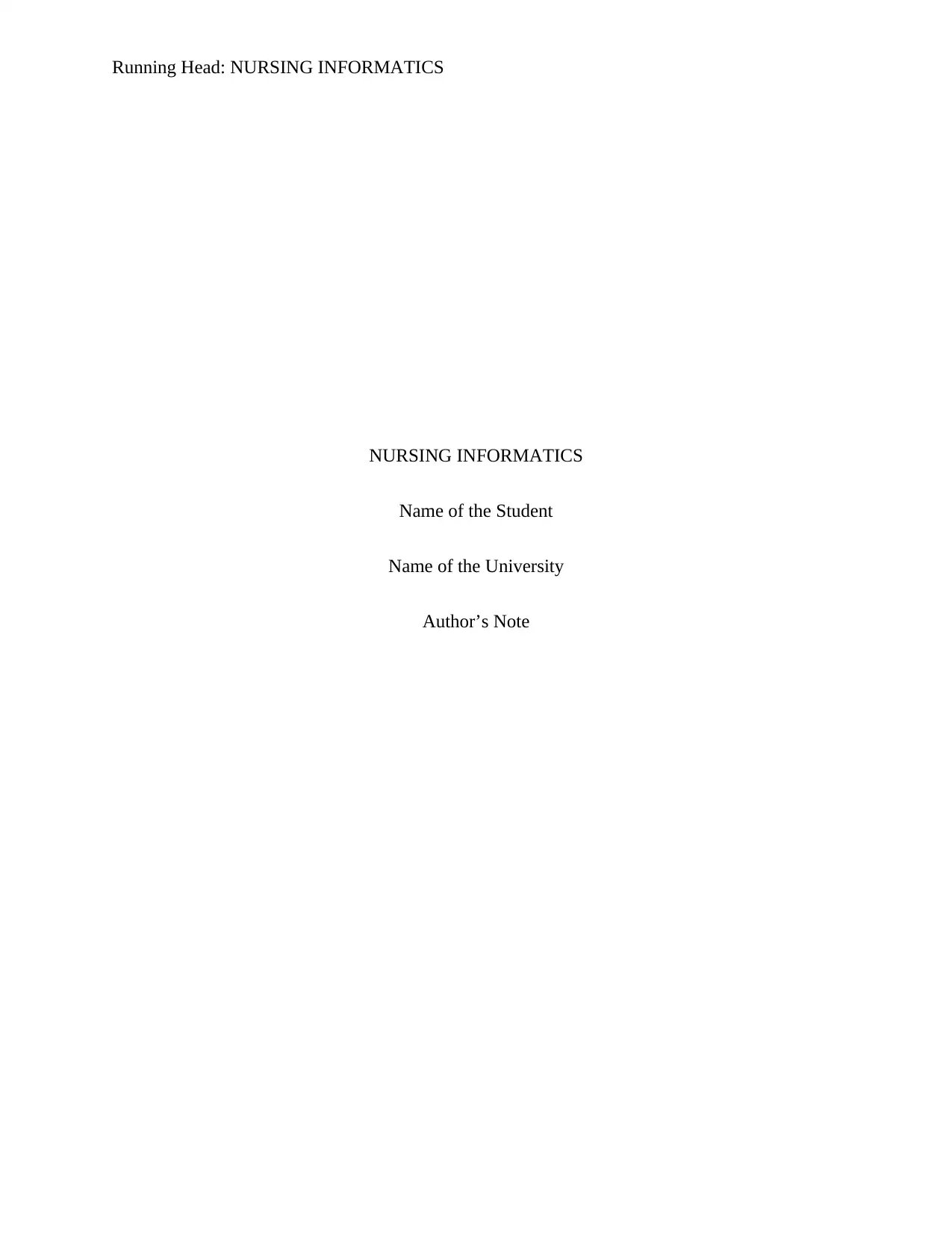
Running Head: NURSING INFORMATICS
NURSING INFORMATICS
Name of the Student
Name of the University
Author’s Note
NURSING INFORMATICS
Name of the Student
Name of the University
Author’s Note
Paraphrase This Document
Need a fresh take? Get an instant paraphrase of this document with our AI Paraphraser
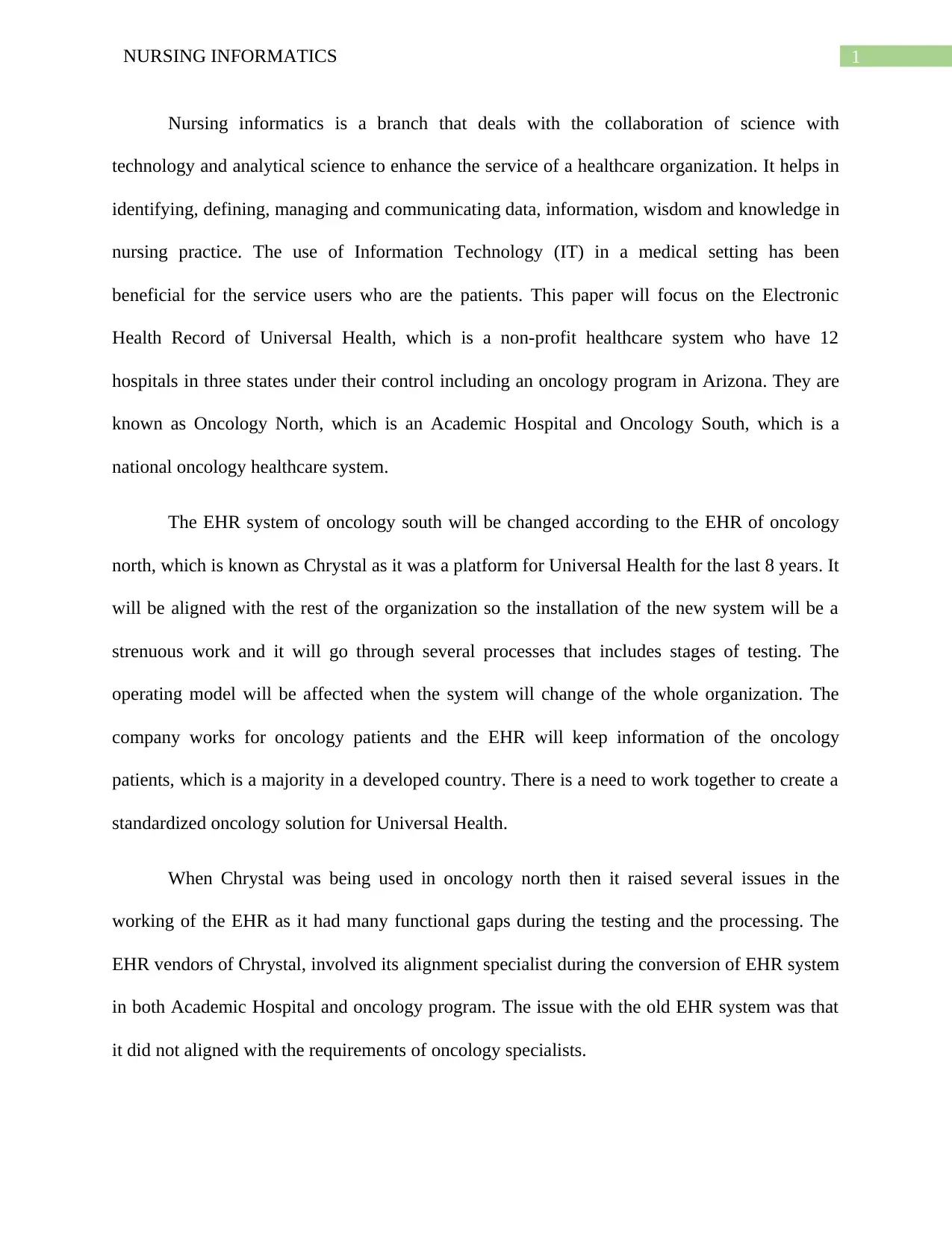
1NURSING INFORMATICS
Nursing informatics is a branch that deals with the collaboration of science with
technology and analytical science to enhance the service of a healthcare organization. It helps in
identifying, defining, managing and communicating data, information, wisdom and knowledge in
nursing practice. The use of Information Technology (IT) in a medical setting has been
beneficial for the service users who are the patients. This paper will focus on the Electronic
Health Record of Universal Health, which is a non-profit healthcare system who have 12
hospitals in three states under their control including an oncology program in Arizona. They are
known as Oncology North, which is an Academic Hospital and Oncology South, which is a
national oncology healthcare system.
The EHR system of oncology south will be changed according to the EHR of oncology
north, which is known as Chrystal as it was a platform for Universal Health for the last 8 years. It
will be aligned with the rest of the organization so the installation of the new system will be a
strenuous work and it will go through several processes that includes stages of testing. The
operating model will be affected when the system will change of the whole organization. The
company works for oncology patients and the EHR will keep information of the oncology
patients, which is a majority in a developed country. There is a need to work together to create a
standardized oncology solution for Universal Health.
When Chrystal was being used in oncology north then it raised several issues in the
working of the EHR as it had many functional gaps during the testing and the processing. The
EHR vendors of Chrystal, involved its alignment specialist during the conversion of EHR system
in both Academic Hospital and oncology program. The issue with the old EHR system was that
it did not aligned with the requirements of oncology specialists.
Nursing informatics is a branch that deals with the collaboration of science with
technology and analytical science to enhance the service of a healthcare organization. It helps in
identifying, defining, managing and communicating data, information, wisdom and knowledge in
nursing practice. The use of Information Technology (IT) in a medical setting has been
beneficial for the service users who are the patients. This paper will focus on the Electronic
Health Record of Universal Health, which is a non-profit healthcare system who have 12
hospitals in three states under their control including an oncology program in Arizona. They are
known as Oncology North, which is an Academic Hospital and Oncology South, which is a
national oncology healthcare system.
The EHR system of oncology south will be changed according to the EHR of oncology
north, which is known as Chrystal as it was a platform for Universal Health for the last 8 years. It
will be aligned with the rest of the organization so the installation of the new system will be a
strenuous work and it will go through several processes that includes stages of testing. The
operating model will be affected when the system will change of the whole organization. The
company works for oncology patients and the EHR will keep information of the oncology
patients, which is a majority in a developed country. There is a need to work together to create a
standardized oncology solution for Universal Health.
When Chrystal was being used in oncology north then it raised several issues in the
working of the EHR as it had many functional gaps during the testing and the processing. The
EHR vendors of Chrystal, involved its alignment specialist during the conversion of EHR system
in both Academic Hospital and oncology program. The issue with the old EHR system was that
it did not aligned with the requirements of oncology specialists.
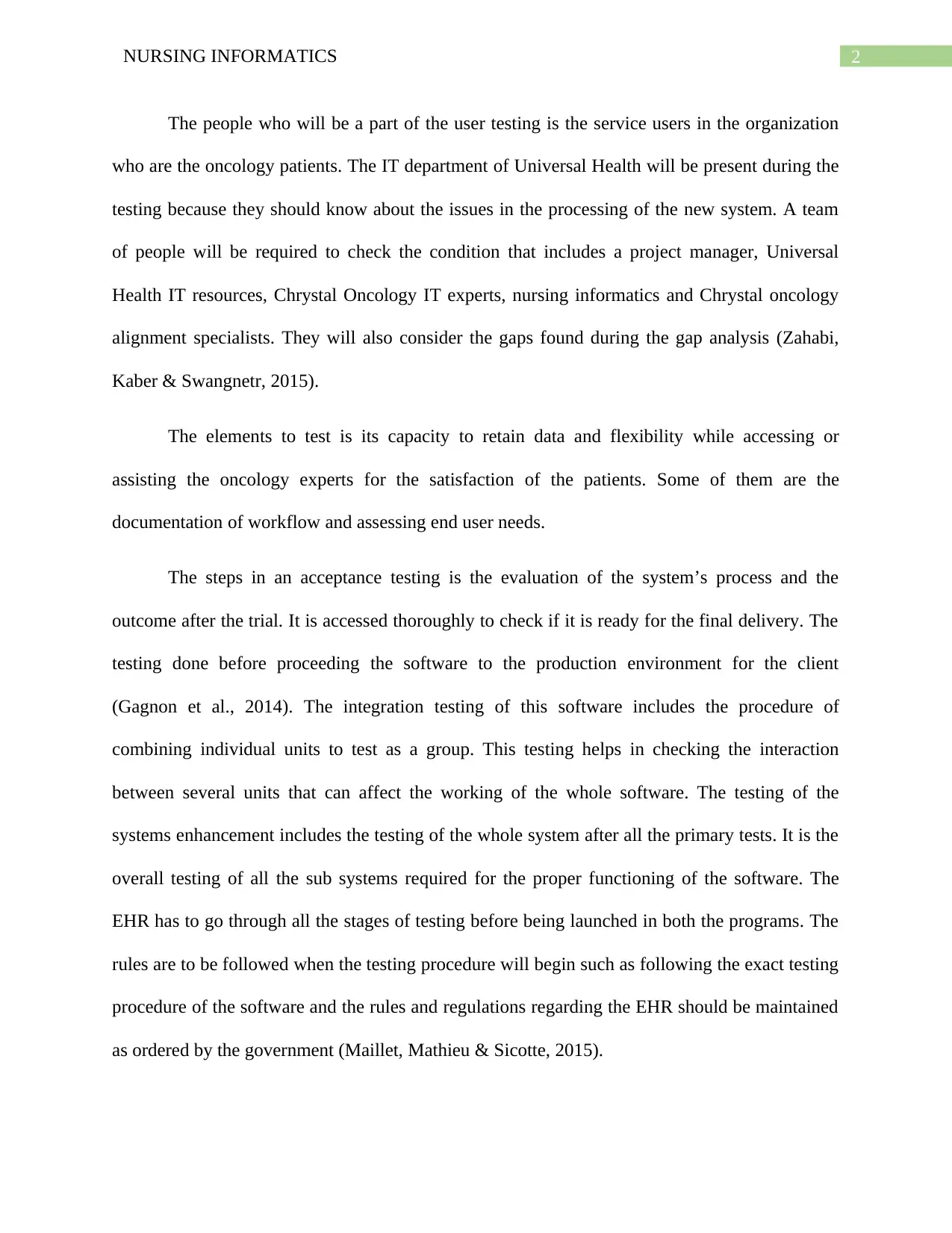
2NURSING INFORMATICS
The people who will be a part of the user testing is the service users in the organization
who are the oncology patients. The IT department of Universal Health will be present during the
testing because they should know about the issues in the processing of the new system. A team
of people will be required to check the condition that includes a project manager, Universal
Health IT resources, Chrystal Oncology IT experts, nursing informatics and Chrystal oncology
alignment specialists. They will also consider the gaps found during the gap analysis (Zahabi,
Kaber & Swangnetr, 2015).
The elements to test is its capacity to retain data and flexibility while accessing or
assisting the oncology experts for the satisfaction of the patients. Some of them are the
documentation of workflow and assessing end user needs.
The steps in an acceptance testing is the evaluation of the system’s process and the
outcome after the trial. It is accessed thoroughly to check if it is ready for the final delivery. The
testing done before proceeding the software to the production environment for the client
(Gagnon et al., 2014). The integration testing of this software includes the procedure of
combining individual units to test as a group. This testing helps in checking the interaction
between several units that can affect the working of the whole software. The testing of the
systems enhancement includes the testing of the whole system after all the primary tests. It is the
overall testing of all the sub systems required for the proper functioning of the software. The
EHR has to go through all the stages of testing before being launched in both the programs. The
rules are to be followed when the testing procedure will begin such as following the exact testing
procedure of the software and the rules and regulations regarding the EHR should be maintained
as ordered by the government (Maillet, Mathieu & Sicotte, 2015).
The people who will be a part of the user testing is the service users in the organization
who are the oncology patients. The IT department of Universal Health will be present during the
testing because they should know about the issues in the processing of the new system. A team
of people will be required to check the condition that includes a project manager, Universal
Health IT resources, Chrystal Oncology IT experts, nursing informatics and Chrystal oncology
alignment specialists. They will also consider the gaps found during the gap analysis (Zahabi,
Kaber & Swangnetr, 2015).
The elements to test is its capacity to retain data and flexibility while accessing or
assisting the oncology experts for the satisfaction of the patients. Some of them are the
documentation of workflow and assessing end user needs.
The steps in an acceptance testing is the evaluation of the system’s process and the
outcome after the trial. It is accessed thoroughly to check if it is ready for the final delivery. The
testing done before proceeding the software to the production environment for the client
(Gagnon et al., 2014). The integration testing of this software includes the procedure of
combining individual units to test as a group. This testing helps in checking the interaction
between several units that can affect the working of the whole software. The testing of the
systems enhancement includes the testing of the whole system after all the primary tests. It is the
overall testing of all the sub systems required for the proper functioning of the software. The
EHR has to go through all the stages of testing before being launched in both the programs. The
rules are to be followed when the testing procedure will begin such as following the exact testing
procedure of the software and the rules and regulations regarding the EHR should be maintained
as ordered by the government (Maillet, Mathieu & Sicotte, 2015).
⊘ This is a preview!⊘
Do you want full access?
Subscribe today to unlock all pages.

Trusted by 1+ million students worldwide
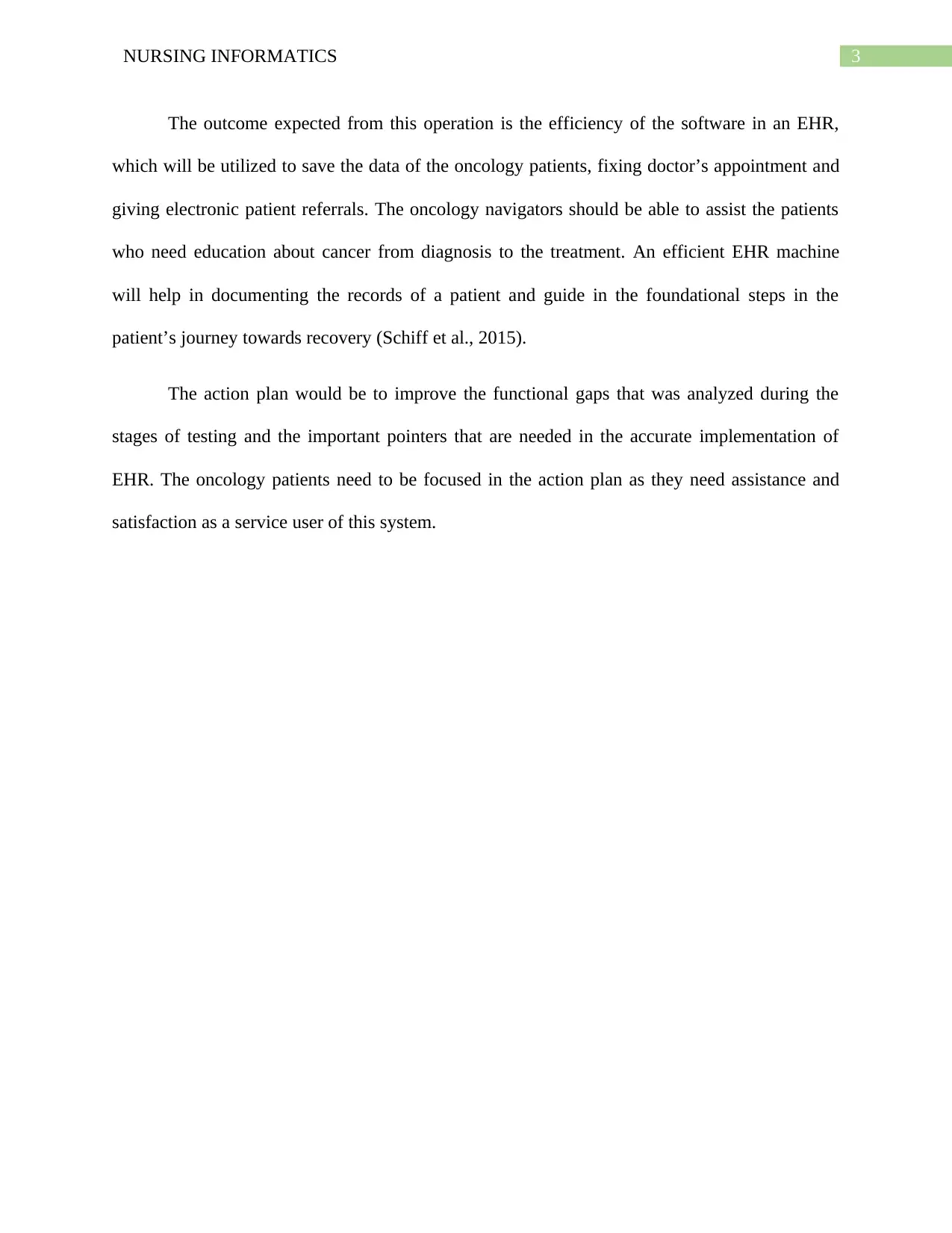
3NURSING INFORMATICS
The outcome expected from this operation is the efficiency of the software in an EHR,
which will be utilized to save the data of the oncology patients, fixing doctor’s appointment and
giving electronic patient referrals. The oncology navigators should be able to assist the patients
who need education about cancer from diagnosis to the treatment. An efficient EHR machine
will help in documenting the records of a patient and guide in the foundational steps in the
patient’s journey towards recovery (Schiff et al., 2015).
The action plan would be to improve the functional gaps that was analyzed during the
stages of testing and the important pointers that are needed in the accurate implementation of
EHR. The oncology patients need to be focused in the action plan as they need assistance and
satisfaction as a service user of this system.
The outcome expected from this operation is the efficiency of the software in an EHR,
which will be utilized to save the data of the oncology patients, fixing doctor’s appointment and
giving electronic patient referrals. The oncology navigators should be able to assist the patients
who need education about cancer from diagnosis to the treatment. An efficient EHR machine
will help in documenting the records of a patient and guide in the foundational steps in the
patient’s journey towards recovery (Schiff et al., 2015).
The action plan would be to improve the functional gaps that was analyzed during the
stages of testing and the important pointers that are needed in the accurate implementation of
EHR. The oncology patients need to be focused in the action plan as they need assistance and
satisfaction as a service user of this system.
Paraphrase This Document
Need a fresh take? Get an instant paraphrase of this document with our AI Paraphraser
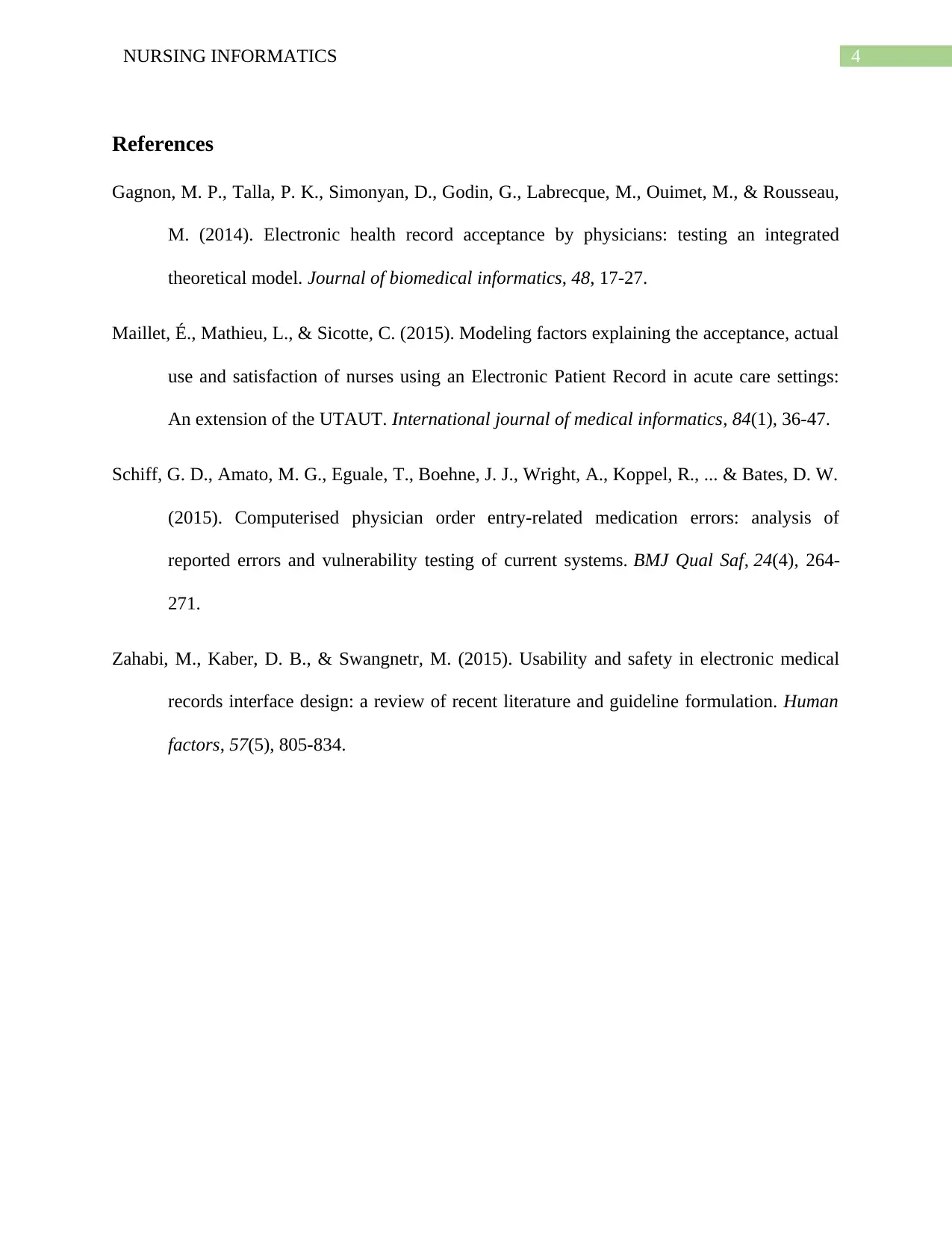
4NURSING INFORMATICS
References
Gagnon, M. P., Talla, P. K., Simonyan, D., Godin, G., Labrecque, M., Ouimet, M., & Rousseau,
M. (2014). Electronic health record acceptance by physicians: testing an integrated
theoretical model. Journal of biomedical informatics, 48, 17-27.
Maillet, É., Mathieu, L., & Sicotte, C. (2015). Modeling factors explaining the acceptance, actual
use and satisfaction of nurses using an Electronic Patient Record in acute care settings:
An extension of the UTAUT. International journal of medical informatics, 84(1), 36-47.
Schiff, G. D., Amato, M. G., Eguale, T., Boehne, J. J., Wright, A., Koppel, R., ... & Bates, D. W.
(2015). Computerised physician order entry-related medication errors: analysis of
reported errors and vulnerability testing of current systems. BMJ Qual Saf, 24(4), 264-
271.
Zahabi, M., Kaber, D. B., & Swangnetr, M. (2015). Usability and safety in electronic medical
records interface design: a review of recent literature and guideline formulation. Human
factors, 57(5), 805-834.
References
Gagnon, M. P., Talla, P. K., Simonyan, D., Godin, G., Labrecque, M., Ouimet, M., & Rousseau,
M. (2014). Electronic health record acceptance by physicians: testing an integrated
theoretical model. Journal of biomedical informatics, 48, 17-27.
Maillet, É., Mathieu, L., & Sicotte, C. (2015). Modeling factors explaining the acceptance, actual
use and satisfaction of nurses using an Electronic Patient Record in acute care settings:
An extension of the UTAUT. International journal of medical informatics, 84(1), 36-47.
Schiff, G. D., Amato, M. G., Eguale, T., Boehne, J. J., Wright, A., Koppel, R., ... & Bates, D. W.
(2015). Computerised physician order entry-related medication errors: analysis of
reported errors and vulnerability testing of current systems. BMJ Qual Saf, 24(4), 264-
271.
Zahabi, M., Kaber, D. B., & Swangnetr, M. (2015). Usability and safety in electronic medical
records interface design: a review of recent literature and guideline formulation. Human
factors, 57(5), 805-834.
1 out of 5
Related Documents
Your All-in-One AI-Powered Toolkit for Academic Success.
+13062052269
info@desklib.com
Available 24*7 on WhatsApp / Email
![[object Object]](/_next/static/media/star-bottom.7253800d.svg)
Unlock your academic potential
Copyright © 2020–2025 A2Z Services. All Rights Reserved. Developed and managed by ZUCOL.





